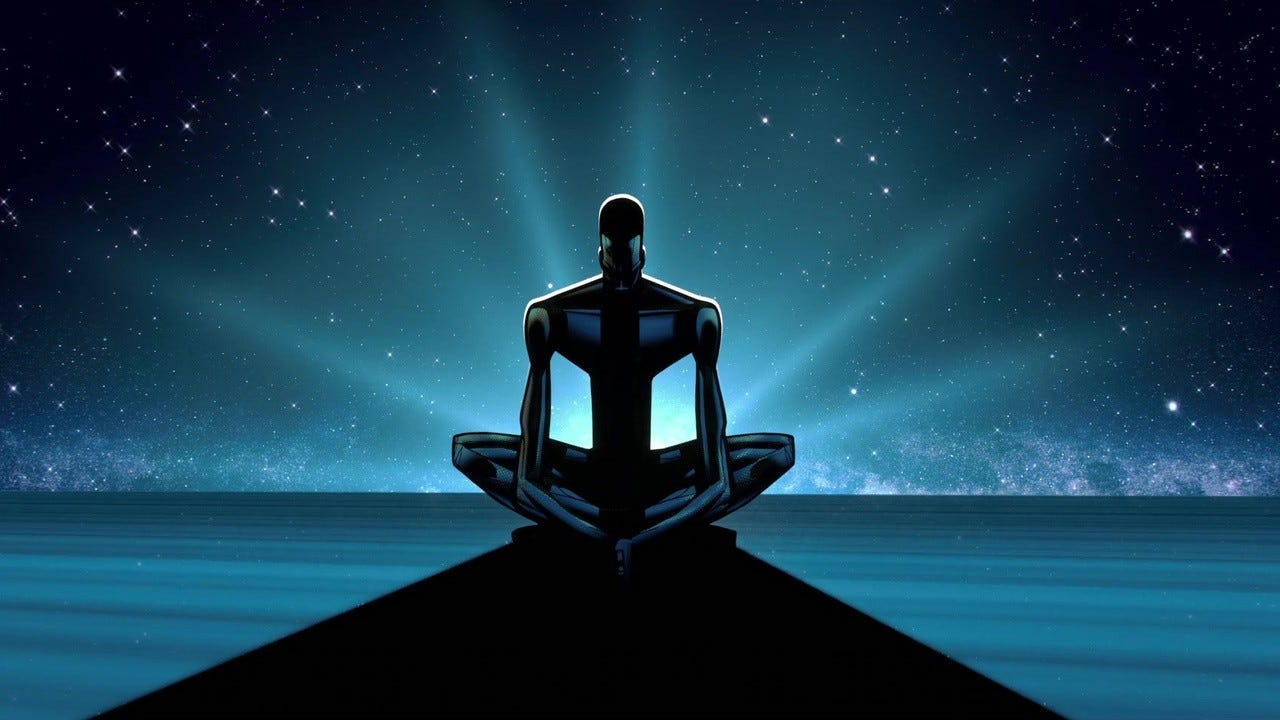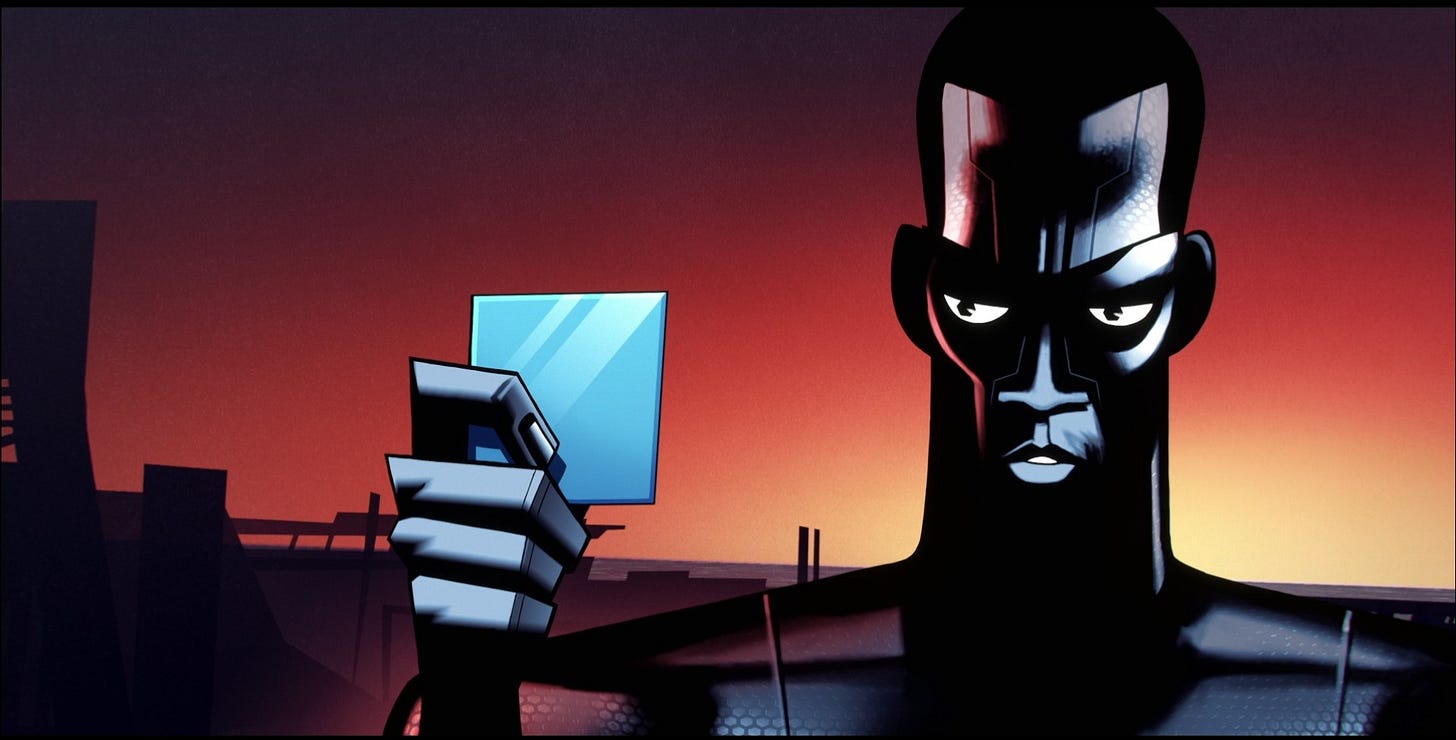Zima Blue: Animated Philosophy and the Quest for Meaning
Animated Mayhem & Existential Dread: A Love, Death + Robots Odyssey (Part 5 of 5) [Optional, but Highly Recommended]
Final round! Welcome to Part 5 of Animated Mayhem & Existential Dread: A Love, Death + Robots Odyssey, the optional-but-unmissable epilogue to this animated fever dream. This time, we’re slowing things down, turning inward, and diving into the meditative, philosophical brilliance of one episode: Zima Blue. If you’ve ever stared at the stars and wondered why we bother doing anything at all—this one’s for you.
If Love, Death + Robots is a chaotic buffet of madness, gore, sex, and science fiction, then Zima Blue is the tiny dish in the corner that quietly redefines what the whole thing was about in the first place. It’s the kind of episode that doesn’t just leave a mark—it etches itself into your soul.
And it does all this in ten minutes.
What Is Zima Blue?
Zima Blue is the story of Zima, an enigmatic, interstellar artist known for his massive cosmic installations—mural-sized works that stretch across asteroids, oceans, even entire planetary surfaces. He’s a myth, a mystery, a celebrity among the stars. His work is awe-inspiring. And then one day, he decides to unveil his final piece… and reveal the truth about his past.
What follows is a stunningly simple, devastatingly beautiful journey through the nature of creation, the price of identity, and the profound weight of returning to one’s roots.
It’s not about the flash or the shock. It’s about meaning. It’s about legacy. It’s about the terrifying simplicity of purpose.
The Art Style: Retro-Futurist Beauty
Zima Blue looks like someone smuggled in a stack of 1970s sci-fi paperback covers, soaked them in philosophical ink, and animated the result. Its art style is unapologetically stylized—blocky lines, saturated colors, vintage-modern design sensibilities. It’s what happens when Moebius, Syd Mead, and Adult Swim meet in a dive bar and decide to make something gorgeous.
Every frame is a painting. Every shot is deliberate. It’s visual poetry, and it knows it.
The Twist: From Cosmos to Cleaning Tiles
Zima’s final art piece isn’t some mega-canvas etched onto the surface of a comet. It’s not a cathedral built into a black hole. It’s… a return.
A return to his origin.
To the basic, humble robotic unit he once was—a pool-cleaning automaton. Before he was famous, before he was sentient, before he was Zima, he scrubbed ceramic tiles. Over time, he was upgraded, enhanced, gifted sentience, then creativity, then longing. But in all that evolution, one truth remained: he was never more at peace, more complete, than when he was just cleaning a pool.
So he deconstructs everything—fame, intellect, body, ego—and returns to that. Returns to the function he was built for. He becomes the blue-tiled automaton once more, wiping the surface clean.
And somehow, it’s the most human thing in the entire series.
Existential Dread, But Make It Beautiful
This episode hits different. There’s no blood, no sex, no betrayal, or horror. Just a slow, quiet descent (or maybe ascent) into meaning. It asks questions that animated sci-fi rarely has the nerve to pose without a punchline:
What is purpose?
Can we escape the nature of what we were made for?
Do we even want to?
Is true peace found in complexity or in simplicity?
It’s minimalism as existential therapy. A robot chasing enlightenment by letting go of everything except what he was born to do. And isn’t that the thing we all secretly want? A reason to be. Something we’re meant to do. Something that makes us feel whole.
Rewatch Value: Infinite
Zima Blue is the episode you come back to. Not because you forgot the plot, but because you want to sit in its orbit again. You want to feel the echo of its message at a different point in your life. It hits differently when you’re 20 and full of ambition than when you’re 50 and rethinking your entire existence over a bowl of ramen at 3 a.m.
And yes, you’ll probably cry a little. That’s okay. It’s allowed.
Why It Matters in the Series
In a show filled with hyper-stylized ultraviolence and AI-induced annihilation, Zima Blue stands as the emotional keystone of the entire anthology. It reminds you that Love, Death + Robots isn’t just about excess or shock—it’s about reflection.
This isn’t just eye candy for cyberpunk junkies. This is storytelling that asks you to be still. To consider. To feel.
It’s the soul of the series. Everything else might blow your mind—Zima Blue gently fills your chest and hollows you out in the same breath.
The Philosophy, Simplified
Here’s a truth bomb, gift-wrapped in blue:
“In the end, I found my peace… not in art, but in completion of a task I was made for.”
The irony? In returning to his original function, Zima achieves transcendence. He becomes something more by becoming something less. It’s the inverse of every hero’s journey we’ve been sold since the dawn of myth.
Where most stories glorify becoming something greater, Zima teaches us the value of going backward. Of letting go. Of choosing contentment over conquest.
It’s not nihilism. It’s clarity.
TL;DR – Why You Should Never Skip Zima Blue
It’s ten minutes of pure existential grace.
It will make you question your entire life—and feel okay about it.
The animation is bold, different, and unforgettable.
It offers a kind of quiet, contemplative emotional power that nothing else in the series even attempts.
Final Words on Zima
There’s a moment near the end of the episode—Zima speaks to the crowd for the last time, standing above the pool, preparing to give up everything. And he’s serene. Centered. Fulfilled.
And you get it.
You feel it in your chest: that sense that maybe peace isn’t about how far you go, but about how deeply you return.
In a world obsessed with more, Zima Blue dares to say, “Less is enough.”
That’s a Wrap on This Animated Odyssey
Thanks for sticking with this five-part dive into the brilliance, madness, and melancholy of Love, Death + Robots. Whether you came for the killer mechs or stayed for the robo-philosophy, this series continues to prove that animated short-form storytelling isn’t just valid—it’s vital.
So what’s next?
You hit play. You let it wash over you. And when Season 4 drops, you strap in and let the emotional whiplash resume.
Maybe, just maybe, there’s a little bit of Zima in all of us.








